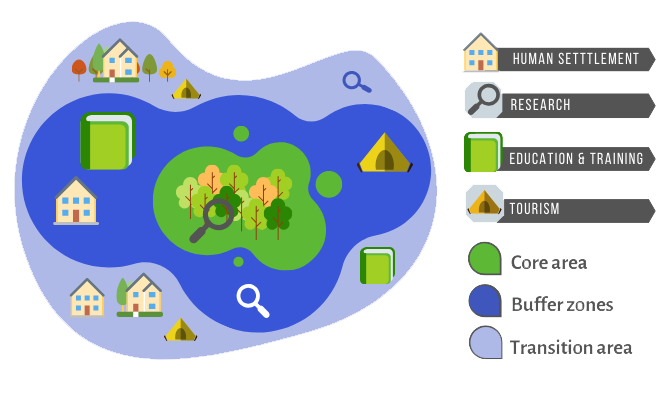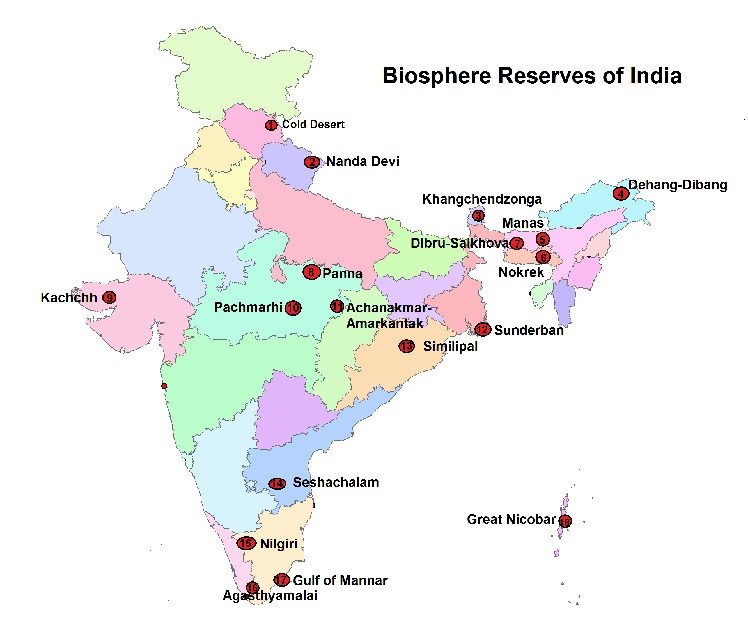Context:
From 2022 onwards, 3rd November will be celebrated as ‘The International Day for Biosphere Reserves’.
Relevance:
GS III: Environment and Ecology
Dimensions of the Article:
- What are Biosphere Reserves?
- Status of Biosphere Reserves in India
- International Status of Biosphere Reserve
What are Biosphere Reserves?
- Biosphere reserves are ‘learning places for sustainable development’.
- They are sites for testing interdisciplinary approaches to understanding and managing changes and inters between social and ecological systems, including conflict prevention and management of biodiversity.
- They are places that provide local solutions to global challenges.
- Biosphere reserves include terrestrial, marine and coastal ecosystems. Each site promotes solutions reconciling the conservation of biodiversity with its sustainable use.
- Biosphere reserves are nominated by national governments and remain under the sovereign jurisdiction of the states where they are located.
- Biosphere Reserves are designated under the intergovernmental MAB Programme by the Director-General of UNESCO following the decisions of the MAB International Coordinating Council (MAB ICC).
- Biosphere Reserves involve local communities and all interested stakeholders in planning and management.
Main functions of Biosphere reserves:
- Conservation of biodiversity and cultural diversity
- Economic development that is socio-culturally and environmentally sustainable
- Logistic support, underpinning development through research, monitoring, education and training
Three main zones

- Core Areas
- It comprises a strictly protected zone that contributes to the conservation of landscapes, ecosystems, species and genetic variation
- Buffer Zones
- It surrounds or adjoins the core area(s), and is used for activities compatible with sound ecological practices that can reinforce scientific research, monitoring, training and education.
- Transition Area
- The transition area is where communities foster socio-culturally and ecologically sustainable economic and human activities.
Status of Biosphere Reserves in India
- India now has 18 designated biosphere reserves totaling 60,000 square kilometres.
- The blue mountains of the Nilgiris, which span Tamil Nadu, Karnataka, and Kerala, were India’s first biosphere reserve.
- Dibru-Saikhowa (Assam) is the smallest while the Gulf of Kachchh (in Gujarat) is the largest biosphere reserve .
18 biosphere reserves in India:
- Cold Desert, Himachal Pradesh
- Nanda Devi, Uttarakhand
- Khangchendzonga, Sikkim
- Dehang-Debang, Arunachal Pradesh
- Manas, Assam
- Dibru-Saikhowa, Assam
- Nokrek, Meghalaya
- Panna, Madhya Pradesh
- Pachmarhi, Madhya Pradesh
- Achanakmar-Amarkantak, Madhya Pradesh-Chhattisgarh
- Kachchh, Gujarat (Largest Area)
- Similipal, Odisha
- Sundarban, West Bengal
- Seshachalam, Andhra Pradesh
- Agasthyamala, Karnataka-Tamil Nadu-Kerala
- Nilgiri, Tamil Nadu-Kerala (First to be Included)
- Gulf of Mannar, Tamil Nadu
- Great Nicobar, Andaman & Nicobar Island

International Status of Biosphere Reserve
- For natural areas, UNESCO has established the term “Biosphere Reserve” to reduce conflicts between development and preservation.
- Under the Man and Biosphere Reserve Program of UNESCO, national governments that meet a minimal set of requirements can nominate biosphere reserves.
- There are currently 738 biosphere reserves in 134 countries, including 22 transboundary sites.
- There are 738 biosphere reserves in 134 countries, including 22 transboundary sites, according to UNESCO.
- The highest number of such sites are in Spain, Russia and Mexico.
Man and Biosphere Programme
- The MAB programme is an intergovernmental scientific programme that aims to establish a scientific basis for enhancing the relationship between people and their environments.
- It combines the natural and social sciences with a view to improving human livelihoods and safeguarding natural and managed ecosystems, thus promoting innovative approaches to economic development that are socially and culturally appropriate and environmentally sustainable.
- There are total 12 biosphere reserves of India which have been recognized internationally under Man and Biosphere Reserve program
-Source: The Hindu





